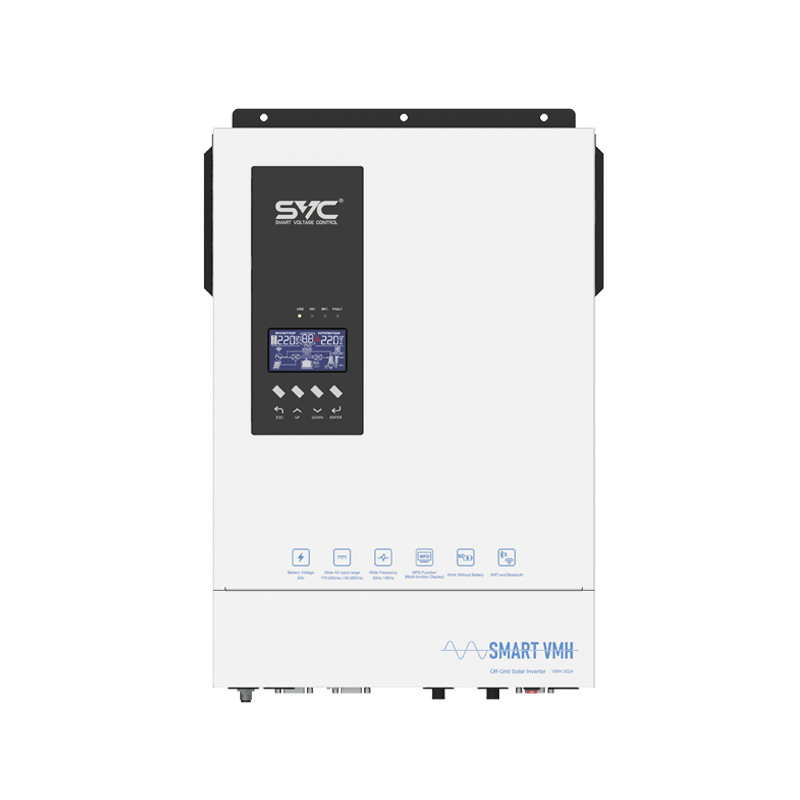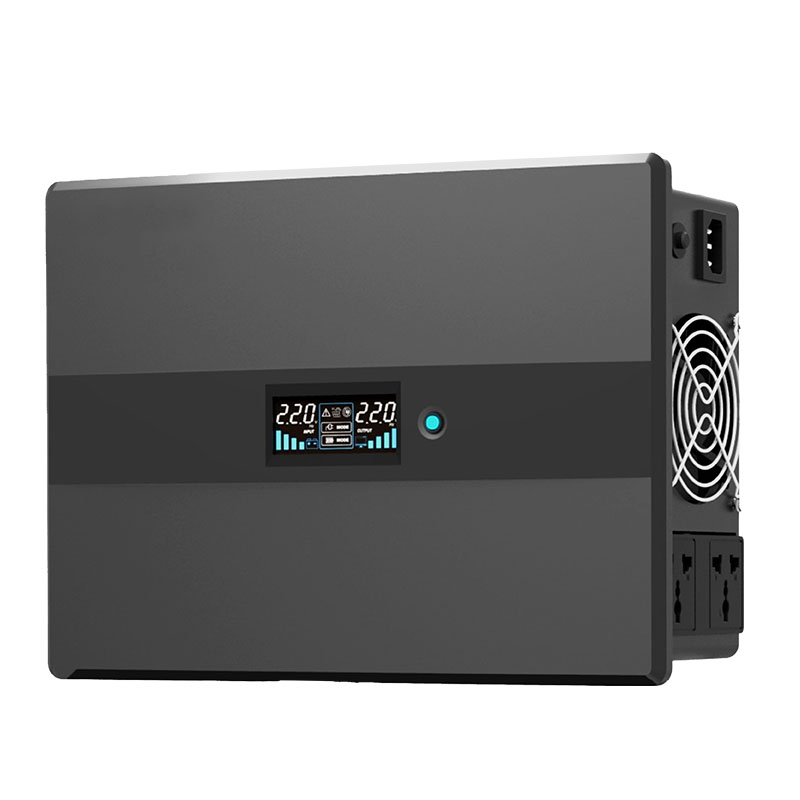
Off-grid inverter: Everything You Need To Know
2023-12-12 00:00
If you are thinking of living off the grid with solar energy, you will need an off-grid inverter to convert the direct current (DC) electricity from your solar panels or battery bank into alternating current (AC) electricity that can power your household appliances and devices. But what is an off-grid inverter, and how does it work? In this article, I will explain the basics of off-grid inverters, their types, features, benefits, and drawbacks, and how to choose the best one for your needs.
What is an off-grid inverter?
An off-grid inverter is a device that converts DC electricity from a renewable energy source, such as solar, wind, or hydro, into AC electricity that can be used by standard appliances and devices. Unlike an on-grid inverter, which synchronizes with the public grid and feeds excess electricity back to it, an off-grid inverter operates independently and relies on a battery bank to store excess electricity for later use. An off-grid inverter is also known as a standalone inverter, an island inverter, or a battery-based inverter.
How does an off-grid inverter work?
An off-grid power inverter works by using a transformer and a switching circuit to change the voltage, frequency, and waveform of the DC electricity from the solar panels or battery bank. The transformer steps up or down the voltage to match the AC output required by the appliances and devices. The switching circuit uses transistors or MOSFETs to switch the DC electricity on and off at a high frequency, creating a pulsating DC waveform. The waveform is then filtered and smoothed to produce a pure sine wave, a modified sine wave, or a square wave AC output .
What are the types of off-grid inverters?
There are three main types of off-grid inverters, based on the waveform of their AC output:
• Pure sine wave inverters: These inverters produce a smooth and continuous AC waveform that is identical to the grid electricity. They are the most efficient and reliable type of off-grid inverters, as they can power any kind of appliance or device without causing noise, interference, or damage. However, they are also the most expensive and complex type of off-grid inverters, as they require more components and sophisticated circuitry. SVC Pure Sine Wave Inverter Off Grid
• Modified sine wave inverters: These inverters produce a stepped and choppy AC waveform that approximates a sine wave. They are less efficient and reliable than pure sine wave inverters, as they can cause some appliances or devices to run poorly, overheat, or malfunction. However, they are also cheaper and simpler than pure sine wave inverters, as they require fewer components and less circuitry.
• Square wave inverters: These inverters produce a square-shaped AC waveform that switches abruptly between positive and negative voltage. They are the least efficient and reliable type of off-grid inverters, as they can only power resistive loads, such as lights and heaters, and can damage sensitive or inductive loads, such as motors and electronics. However, they are also the cheapest and simplest type of off-grid inverters, as they require the least components and circuitry.
What are the features of off-grid inverters?
There are several features that you should look for when choosing an off-grid power inverter, such as:
• Power rating: This is the amount of power that the inverter can deliver continuously to the appliances and devices. It is measured in watts (W) or kilowatts (kW). You should choose an inverter that can handle the total power consumption of your household, plus some margin for safety and future expansion.
• Surge capacity: This is the amount of power that the inverter can deliver for a short period of time to start up appliances and devices that have high initial power requirements, such as refrigerators, air conditioners, and pumps. It is measured in watts (W) or kilowatts (kW). You should choose an inverter that can handle the peak power demand of your household, plus some margin for safety and reliability.
• Efficiency: This is the ratio of the AC output power to the DC input power of the inverter. It is measured in percentage (%). You should choose an inverter that has a high efficiency, as this will reduce the power losses and increase the battery life of your system.
• Voltage: This is the voltage level of the DC input and the AC output of the inverter. It is measured in volts (V). You should choose an inverter that matches the voltage of your solar panels, battery bank, and appliances and devices. The most common voltages for off-grid inverters are 12V, 24V, or 48V for the DC input, and 120V or 240V for the AC output.
• Compatibility: This is the ability of the inverter to work well with other components of your system, such as the solar panels, the battery bank, the charge controller, and the alternative energy source. You should choose an inverter that is compatible with the specifications, features, and functions of your system components, and that can communicate and coordinate with them effectively.
What are the benefits of off-grid inverters?
There are many benefits of using an off-grid power inverter for your solar energy system, such as:
• Independence: An off-grid inverter allows you to generate and use your own electricity without relying on the public grid. This gives you more control and freedom over your energy supply, and protects you from power outages, blackouts, and grid failures.
• Resilience: An off-grid inverter enables you to store excess electricity in a battery bank for later use. This ensures that you have a backup power source in case of low solar generation or high energy demand, and that you can meet your energy needs at any time of the day or night.
• Sustainability: An off-grid inverter helps you to reduce your environmental impact and carbon footprint by using renewable energy sources, such as solar, wind, or hydro, to power your household. This reduces your dependence on fossil fuels and your contribution to greenhouse gas emissions and climate change.
What are the drawbacks of off-grid inverters?
There are also some drawbacks of using an off-grid inverter for your solar energy system, such as:
• Cost: An off-grid inverter can be expensive to purchase and install, especially if you choose a high-quality and high-capacity model. Moreover, an off-grid inverter requires a battery bank, which can add to the initial and maintenance costs of your system .
• Complexity: An off-grid inverter can be complex to design and operate, as it involves many components and variables that need to be considered and coordinated. You may need professional help or technical skills to install and maintain your off-grid inverter, and to troubleshoot any problems or issues that may arise .
• Regulation: An off-grid inverter may be subject to legal and regulatory barriers, such as zoning restrictions, permits, taxes, and incentives, depending on your location and jurisdiction. You may need to comply with certain rules and standards to use your off-grid inverter safely and legally .
How to choose the best off-grid inverter for your needs?
To choose the best off-grid inverter for your needs, you should consider the following factors:
• Your energy consumption: You should calculate the total and peak power consumption of your household, and the daily and seasonal variations of your energy demand. This will help you determine the power rating and surge capacity of your off-grid inverter.
• Your energy generation: You should estimate the solar potential and availability of your location, and the size and output of your solar panels. This will help you determine the voltage and efficiency of your off-grid inverter .
• Your energy storage: You should evaluate the capacity and type of your battery bank, and the charging and discharging cycles of your system. This will help you determine the compatibility and features of your off-grid inverter.
• Your energy backup: You should consider the possibility and frequency of power shortages or surges in your system, and the availability and cost of an alternative energy source, such as a generator, a wind turbine, a hydro turbine, or a grid connection. This will help you determine the reliability and redundancy of your off-grid inverter.
• Your budget and preferences: You should compare the prices and qualities of different models and brands of off-grid inverters, and weigh the benefits and drawbacks of each type and feature. You should also consider your personal preferences and expectations for your system performance and user experience.
Get the latest price? We'll respond as soon as possible(within 12 hours)















